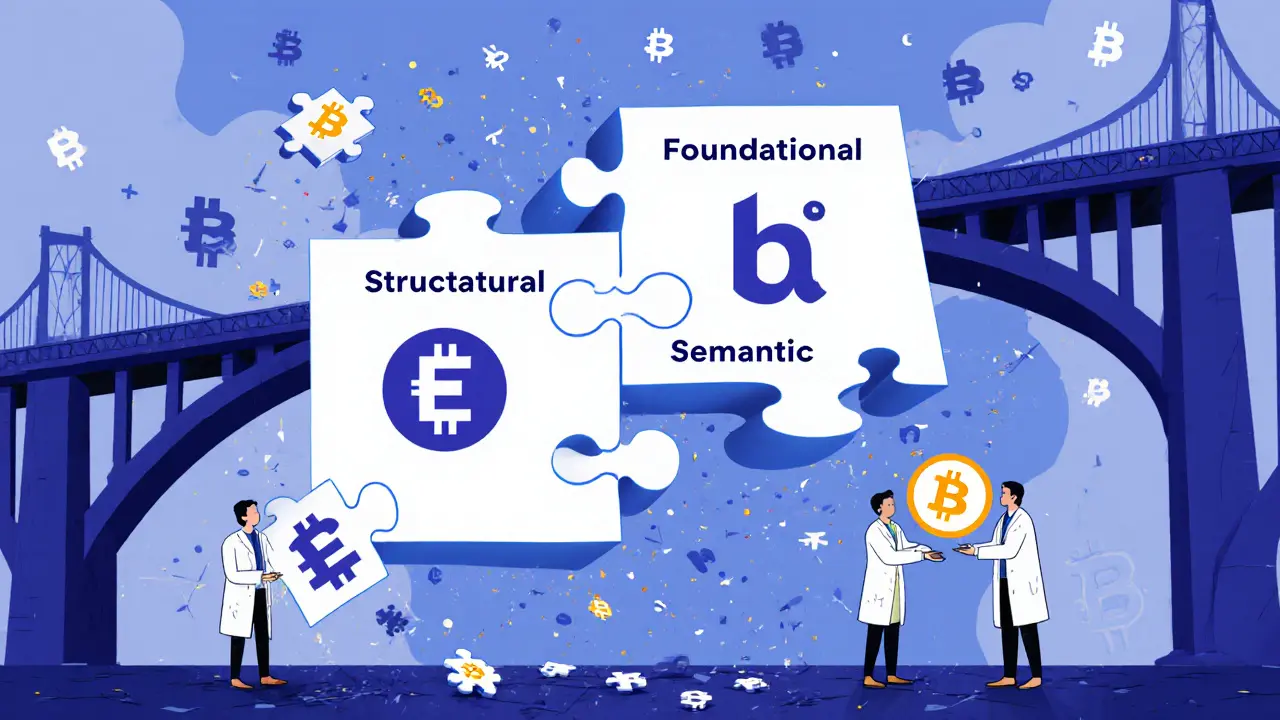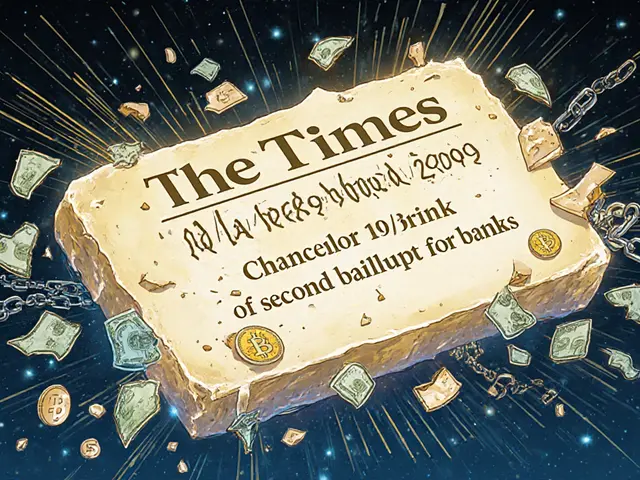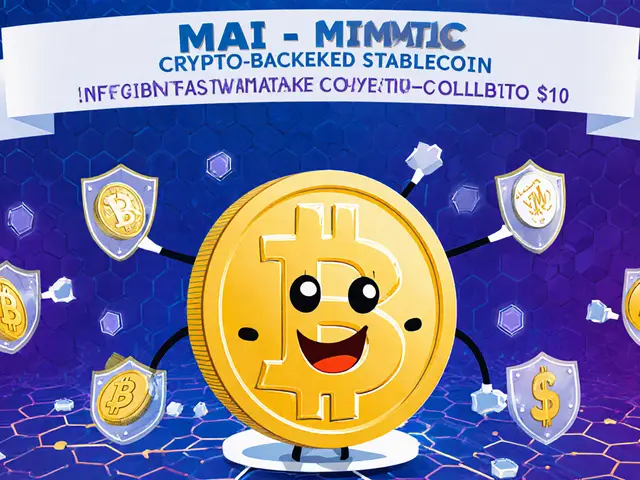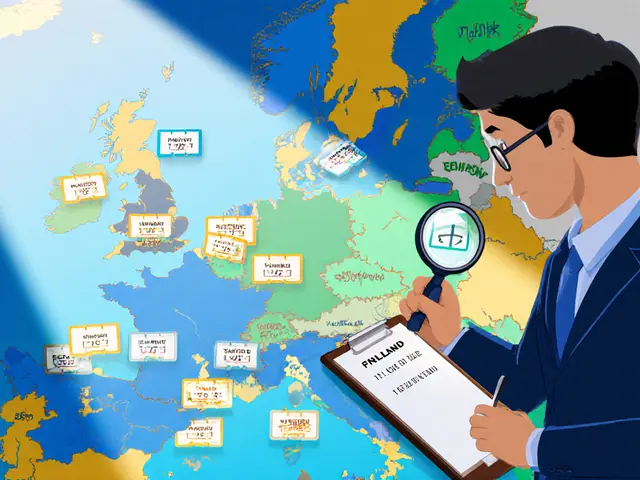Blockchain Interoperability Standards Quiz
Question 1
What are the four levels of interoperability discussed in the article?
Question 2
Which of these is NOT a key component of blockchain interoperability?
Question 3
What is the main reason most cross-chain bridges fail?
Question 4
Which standard is specifically for NFTs?
Question 5
What makes standards like IBC or CCIP safer than custom bridges?
Review your answers to learn more about blockchain interoperability
Blockchain networks were never meant to exist in isolation. Early adopters thought each chain could solve its own problems alone-Bitcoin for payments, Ethereum for smart contracts, Solana for speed. But reality hit fast. If you want to move assets from one chain to another, or use data from a public ledger in a private system, you need more than just good code. You need interoperability protocols and standards.
What Interoperability Really Means in Blockchain
Interoperability isn’t just about connecting blockchains. It’s about making them understand each other. Think of it like two people speaking different languages. If one says "I want to send 5 ETH," and the other hears "I want to send 5 apples," nothing works. Interoperability ensures both sides agree on what "ETH" means, how it’s counted, and how to verify it’s real. There are four levels of interoperability that matter in blockchain:- Foundational: Just getting data across. Chain A sends a transaction hash to Chain B. No interpretation needed.
- Structural: Both chains use the same data format-like JSON or binary encoding-so fields line up correctly. A wallet address on Chain A looks like a wallet address on Chain B.
- Semantic: This is the hard part. Both chains must agree on what a "token" is, what "stake" means, and how to validate a signature. Without this, even if data arrives, it’s useless.
- Organizational: Legal, governance, and trust rules. Who’s responsible if a bridge fails? Who audits the smart contracts? Who pays for downtime?
Most blockchains today are stuck at level one or two. That’s why you see so many broken bridges and lost funds. Real interoperability needs level three-and that’s where standards come in.
How Blockchain Interoperability Works
At its core, interoperability in blockchain relies on three things: data formats, communication protocols, and shared vocabulary.- Data formats: JSON and CBOR are the most common. They’re lightweight, readable, and supported everywhere. Ethereum’s ABI (Application Binary Interface) is a standard for encoding function calls. Cosmos uses Protobuf. These aren’t random choices-they’re engineered for consistency.
- Communication protocols: Most chains use some form of relay or oracle to pass messages. Polkadot uses parachains and a central relay chain. Avalanche’s Subnets talk via the X-Chain. Chainlink’s CCIP is a protocol designed specifically for cross-chain communication. These aren’t just APIs-they’re formalized rules for how systems should talk.
- Shared vocabulary: This is the invisible glue. If Chain A calls a token "ERC-20" and Chain B calls it "FungibleToken-v2," they’re not talking the same language. Standards like ERC-20, ERC-721, and now ERC-4337 define what a token, NFT, or account abstraction must include. Without these, even identical code behaves differently.
Think of it like the internet. No one owns HTTP, but every browser and server follows it. That’s interoperability by design.

Key Standards Making Blockchain Work Together
Several standards are pushing the industry forward. Here are the ones that matter right now:| Standard | Use Case | Key Feature | Adopted By |
|---|---|---|---|
| ERC-20 | Token standard | Defines fungible token functions: transfer, balanceOf, approve | Ethereum, BSC, Polygon, Arbitrum |
| ERC-721 | NFT standard | Standard for unique, non-fungible tokens with metadata | Ethereum, Flow, Tezos |
| Cosmos IBC | Inter-Blockchain Communication | Peer-to-peer message passing between sovereign chains | Cosmos Hub, Osmosis, Injective |
| Polkadot XCMP | Cross-Chain Message Passing | Secure message transfer between parachains via relay chain | Polkadot, Kusama |
| Chainlink CCIP | Cross-Chain Interoperability Protocol | Decentralized messaging with verifiable delivery and security | Multi-chain dApps, DeFi protocols |
| ABI (Application Binary Interface) | Smart contract interface | Standard encoding for function calls and data types | Ethereum, EVM-compatible chains |
These aren’t just tools-they’re agreements. When you use an ERC-20 token on a new chain, you’re trusting that the chain follows the same rules as Ethereum. That’s interoperability in action.
Why Most Cross-Chain Bridges Fail
You’ve probably heard of the $600 million Ronin Bridge hack or the $100 million Wormhole exploit. These weren’t random bugs. They were failures of interoperability standards. Most bridges are built as custom code between two chains. They’re not based on open standards-they’re point-to-point connections. That means:- Each bridge needs its own security model
- Each bridge has its own set of validators
- Each bridge is a single point of failure
Compare that to IBC or CCIP. These are open protocols. Anyone can build a client for them. They’re audited by the community. They don’t rely on a single company’s servers. That’s the difference between a duct-taped connection and a standardized highway.
Interoperability isn’t about speed or low fees. It’s about reliability. And reliability comes from standards, not shortcuts.

The Role of Governance and Trust
Technical standards mean nothing without trust. Who decides what a standard is? Who updates it? What happens if a chain forks and breaks compatibility? Take ERC-20. It’s not a law. It’s a convention. But because thousands of wallets, exchanges, and dApps built around it, it became the de facto rule. That’s how standards win-not by force, but by adoption. Newer protocols like Cosmos and Polkadot have formal governance. Proposals go through on-chain voting. Validators and token holders decide changes. That’s organizational interoperability in practice. Without this, you get fragmentation. One chain supports a feature. Another doesn’t. Users get stuck. Developers have to build six different versions of the same app. That’s the opposite of interoperability.What’s Next for Blockchain Interoperability
The next big leap isn’t another bridge. It’s standardization at the protocol layer.- Universal token standards: A single standard for all assets-fungible, non-fungible, and programmable-across all chains.
- Decentralized identity for chains: A way to prove ownership without relying on centralized oracles.
- Shared security models: Chains can borrow security from larger ones (like Ethereum) without being sidechains.
- Standardized oracle feeds: Reliable, verifiable data from off-chain sources (weather, stock prices, sports scores) that any chain can use.
Projects like EigenLayer and LayerZero are already testing these ideas. But adoption will only happen if developers stop building custom bridges and start building on open standards.
Right now, interoperability is like the early internet-chaotic, fragmented, full of incompatible systems. But we’re moving toward a world where any blockchain can talk to any other, safely and reliably. That’s the goal. And it’s closer than you think.
What’s the difference between interoperability and portability in blockchain?
Portability means you can move a smart contract or token from one chain to another with minimal changes. Interoperability means two chains can interact in real time without moving anything. For example, you can port an ERC-20 token to Solana as a wrapped version. But with interoperability, you can use that same ERC-20 token on Solana without wrapping it-just by sending a message across chains.
Do I need to understand interoperability protocols as a regular crypto user?
You don’t need to code them, but you should understand the risks. If you’re using a cross-chain bridge, check if it’s built on a standard like IBC or CCIP, or if it’s a custom, centralized solution. Custom bridges have higher risk of hacks or shutdowns. Standards are safer because they’re open, audited, and community-governed.
Why don’t all blockchains just use Ethereum’s standards?
Ethereum’s standards are great, but they’re designed for its specific architecture. Chains like Solana or Cardano have different consensus mechanisms and speed goals. Forcing them to use EVM or ERC-20 would slow them down or break their design. Interoperability isn’t about copying Ethereum-it’s about creating common rules that work across different designs.
Can interoperability make blockchains more secure?
Yes-if done right. Custom bridges are risky because they’re isolated and rarely audited. Open standards like IBC and CCIP are built with security in mind from day one. They use cryptographic proofs, decentralized validators, and consensus rules that make manipulation harder. Interoperability isn’t just about connectivity-it’s about building secure, shared infrastructure.
What happens if two blockchains disagree on a standard?
They can’t communicate reliably. That’s why standards need broad adoption. If Chain A uses a custom token format and Chain B only accepts ERC-20, they’ll need a translator (like a bridge). But translators are temporary fixes. Long-term, the industry will converge on the most widely accepted standards-just like HTTP won over other web protocols.












People Comments
interoperability? sounds like a fancy word for "why won’t my crypto move?"
LMAO so now we need standards like we’re in a corporate boardroom? 🤡 Ethereum’s ERC-20 is the only thing that matters. Everything else is just crypto cosplay. 💸✨
Oh please. Standards are just the elite’s way of locking out new chains. You think IBC or XCMP is secure? Nah. It’s just a different kind of centralization with fancy acronyms. 💀
It’s like trying to have a conversation where everyone speaks a different dialect of the same language. You can hear the words, but you don’t know what they mean. Interoperability isn’t about tech-it’s about shared meaning. And that’s a human problem, not a code problem. 🌱
Let’s be real-most blockchain interoperability is just a glorified RPC wrapper with a whitepaper and a venture capital check. ERC-20 isn’t a standard-it’s a cultural hegemony disguised as open protocol. The fact that every new chain still clings to EVM compatibility is less innovation, more colonialism. 🧠⚡